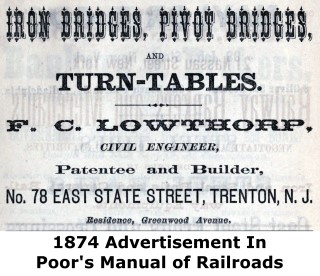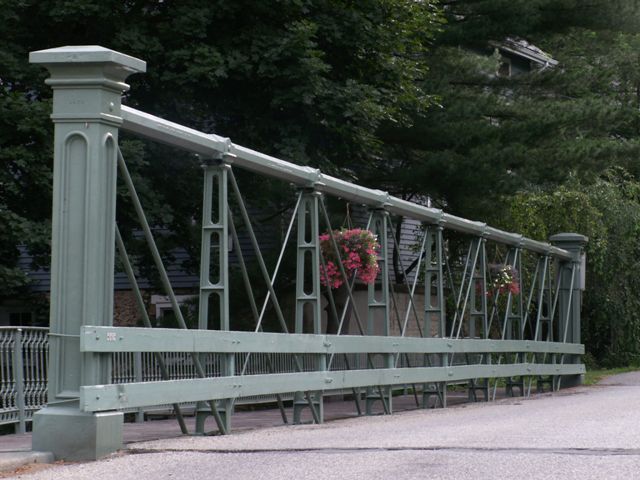We Recommend:
Bach Steel - Experts at historic truss bridge restoration.
BridgeHunter.com Phase 1 is released to the public! - Visit Now
Glen Gardner Bridge
School Street Bridge

Primary Photographer(s): Nathan Holth and Rick McOmber
Bridge Documented: July 11, 2008 and November 8, 2015
Glen Gardner: Hunterdon County, New Jersey: United States
1870 By Builder/Contractor: William Cowin of Lambertville, New Jersey and Engineer/Design: Francis C. Lowthrop
1992
80.1 Feet (24.4 Meters)
84.0 Feet (25.6 Meters)
16.4 Feet (5 Meters)
1 Main Span(s)
10XXG63

View Information About HSR Ratings
Bridge Documentation
View Archived National Bridge Inventory Report - Has Additional Details and Evaluation
View Historic American Engineering Record (HAER) Documentation For This Bridge
View the Original Francis C. Lowthorp patent for the design of this bridge.
View the Original William Johnson patent for the design of this bridge's tension adjustment.
About The Three Cast Iron Trusses In Hunterdon County
This bridge's design was created by Francis C Lowthorp. Lowthorp's name is often misspelled as Lowthrop. Lowthorp is correct and is how it is spelled on the original patent. The bridge was constructed by WM Cowin, which was a company run by William and Charles Cowin.
This bridge is one of three bridges in Hunterdon County which follow the Lowthorp design and were built by Cowin, and they are the only three such bridges in the whole state which utilize cast iron for all compression members/chords on the bridge. These bridges are among a small and elite group of metal truss bridges in the nation, as cast and wrought iron bridges. As pre 1880 bridges, they also are among the oldest metal truss bridges in the country, which is unsurprising given the use of cast iron in the bridges. Cast iron was rapidly replaced by wrought iron for bridge construction after 1870. As extremely old bridges, using cast iron for major structural components, the three Lowthorp/Cowin bridges in New Jersey are among the most important group of historic bridges in the United States.

The Lowthorp/Cowin truss bridges are a true expression of what makes historic metal truss bridges so special. The bridges have a complex appearance to them, yet in the same way they are also simple in their overall design. In design, these bridges are simply pin-connected Pratt pony trusses with vertical members. However, the detail and design in the form of the cast iron beams and components on this bridge is truly remarkable. There are no decorations or embellishments added to the bridge, the decoration and embellishment is the bridge's structural components themselves. Because the components were cast rather than rolled like wrought iron or steel beams, this allowed the fabricator of the bridge to shape the beams in any way they desired. Advantage was taken of this property, and this is evident in the architectural design and treatment of the various cast iron components on the bridge. This property of cast iron also eliminated the need for a separate bridge plaque; instead, information is cast directly on the top chord of the bridge. This would not be found with rolled beams of wrought iron or steel. While the name/brand of the metal is often found on rolled beams, this is a permanent part of the equipment which rolls the beams and cannot be changed easily as a result.
A Patented Tension Adjustment Feature
If you look very closely at the bottom chord connection, you might notice an unusual device that is not normally present on a truss bridge. It is William Johnson's patented tension adjustment device. It operates by passing a pin through an off-center washer-like device that has notches in it. The washer-like device can be turned and because it is off-center, it will increase the distance of the top and bottom chord pins from each other, thus increasing diagonal member tension. The notches allow a second device to be fastened in place to lock the washer-like device in place once adjustment is completed.
The diagram above describing the device and its function may be clicked to see an enlarged version for easier reading.
About The Glen Gardner Bridge
The Glen Gardner Bridge features the highest level of historic integrity of the three Cowin/Lowthorp Bridges. Indeed, for an 1870 bridge which has stood the test of time for around 140 years, and is still serving light vehicular traffic today, the condition of this bridge is incredibly intact and unaltered. Normally over the course of 140 years, repair projects would have altered many parts of the bridge, and sometimes more recent historic preservation rehab projects further alter components of the bridge to maintain its ability to carry vehicular traffic. However, there is not evidence of major alterations to this bridge. The deck stringers of this bridge were replaced in 1992, but deck stringers are not a significant component. Interestingly, floor beams on the bridge are American Standard beams and as such it does not appear that they were replaced in this 1992 project. They may or may not date to the original 1870 structure, but they are old and look appropriate on the bridge.
The unparalleled historic integrity of this bridge coupled with its age and rarity make this bridge one of the most significant historic bridges in the country.
This bridge's excellent condition is truly a tribute to the quality of the construction of this bridge. With modern bridge engineers claiming new bridges can last 100 years as they simultaneously struggle to maintain or end up replacing bridges that are barely 60 years old, it is clear that even with all of our modern technology and knowledge, that no modern bridge offers the quality of materials and construction seen in the historic Glen Gardner Bridge.
The Glen Gardner Bridge includes ornate cast iron pedestrian railings that are a treasure as much as the bridge itself. While brittle compared to wrought iron and steel, and in the long term did not make a good railing material, cast iron did allow fabricators to create truly ornate and unique railing designs. The railings on this bridge which survive intact in great shape are an excellent example of the beauty of cast iron.
This bridge appears to be appreciated by the local community. The Glen Gardner Women's Club is responsible for maintaining the attractive flower displays on the bridge.
While the bridge is on a short residential street, future preservation work to consider for this bridge might be the installation of low-profile guardrails mounted into the deck (not the trusses) on this bridge to protect it from vehicular damage. The railings should be low profile however and not obstruct the bridge.
Information and Findings From New Jersey's Historic Bridge InventoryDiscussion of Bridge The 1870 Pratt pony truss bridge of wrought and cast iron was built by Lambertville contractor William Cowin, using the design of Francis C. Lowthrop. It is one of 3 Cowin/Lowthrop spans extant in New Jersey. The others are 10XXON1 and 2102225, but this is the least altered of the three. It is an extremely significant early example of metal truss bridge technology. The span is of national importance. It was sensitively rehabilitated, including a new flooring system, in 1992. Discussion of Surrounding Area The bridge carries one lane of a local street over a minor stream. It is located in a village of well-maintained 18th- and 19th century homes. It is adjacent to a small neighborhood park and near a 19th century schoolhouse and mill. The village is undergoing modern residential development. The village is east of NJ 31. Bridge Considered Historic By Survey: Yes |
![]()
Photo Galleries and Videos: Glen Gardner Bridge
2008 Bridge Photo-Documentation
Original / Full Size PhotosA collection of overview and detail photos. This gallery offers photos in the highest available resolution and file size in a touch-friendly popup viewer.
Alternatively, Browse Without Using Viewer
![]()
2008 Bridge Photo-Documentation
Mobile Optimized PhotosA collection of overview and detail photos. This gallery features data-friendly, fast-loading photos in a touch-friendly popup viewer.
Alternatively, Browse Without Using Viewer
![]()
2015 Bridge Photo-Documentation
Original / Full Size PhotosA collection of overview and detail photos. This gallery offers photos in the highest available resolution and file size in a touch-friendly popup viewer.
Alternatively, Browse Without Using Viewer
![]()
2015 Bridge Photo-Documentation
Mobile Optimized PhotosA collection of overview and detail photos. This gallery features data-friendly, fast-loading photos in a touch-friendly popup viewer.
Alternatively, Browse Without Using Viewer
![]()
Maps and Links: Glen Gardner Bridge
Coordinates (Latitude, Longitude):
Search For Additional Bridge Listings:
Bridgehunter.com: View listed bridges within 0.5 miles (0.8 kilometers) of this bridge.
Bridgehunter.com: View listed bridges within 10 miles (16 kilometers) of this bridge.
Additional Maps:
Google Streetview (If Available)
GeoHack (Additional Links and Coordinates)
Apple Maps (Via DuckDuckGo Search)
Apple Maps (Apple devices only)
Android: Open Location In Your Map or GPS App
Flickr Gallery (Find Nearby Photos)
Wikimedia Commons (Find Nearby Photos)
Directions Via Sygic For Android
Directions Via Sygic For iOS and Android Dolphin Browser
USGS National Map (United States Only)
Historical USGS Topo Maps (United States Only)
Historic Aerials (United States Only)
CalTopo Maps (United States Only)




